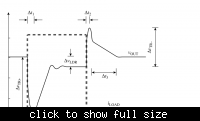massive_attack
Newbie level 6
hola!
I'd like to ask you about transient response of LDO.
typically it looks like this

I'm considering time \[\delta\]t3 . It's related to Cout slewing by feedback resistors or another sink.
The thing that in my simple design which is simple two stage opamp + pmos device this time is not shorter when I use 10x smaller resistors.
In the test bench I use worst case situation loading from 0 to Imax and back to 0 (tr,tf =1ns) with ESR=0(which is not true normally).
GBW of the system is 500kHz, PM > 70deg
What can be the reason of such long time? Should i worry that ? The output is about 70mV higher than should be.
regards
I'd like to ask you about transient response of LDO.
typically it looks like this

I'm considering time \[\delta\]t3 . It's related to Cout slewing by feedback resistors or another sink.
The thing that in my simple design which is simple two stage opamp + pmos device this time is not shorter when I use 10x smaller resistors.
In the test bench I use worst case situation loading from 0 to Imax and back to 0 (tr,tf =1ns) with ESR=0(which is not true normally).
GBW of the system is 500kHz, PM > 70deg
What can be the reason of such long time? Should i worry that ? The output is about 70mV higher than should be.
regards